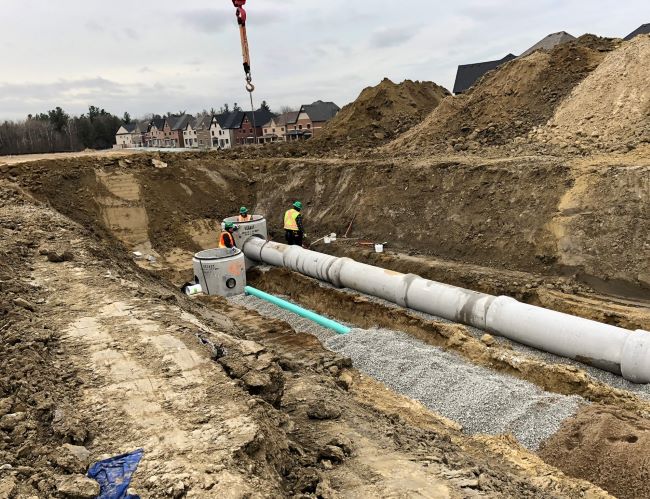Inflow and infiltration (I&I) happens when groundwater, stormwater or snowmelt enter the sanitary sewage system through sump pumps, downspouts, foundation drains and/or holes and cracks in pipes, which can lead to basement flooding, less efficient sewage treatment, overflows into the environment and reduced life expectancy of infrastructure. With increasing severity and frequency of rainfall events due to climate change, the negative impacts of I&I are more keenly felt by municipalities, pushing them to develop strategies to meet the increasing risks.
York Region in action
In 2011, The Regional Municipality of York developed its first I&I Reduction Strategy, in collaboration with its nine local cities and towns, which set a target to reduce 40 million litres per day (MLD) of I&I in the York Durham Sewer System by 2031.
The Region uses flow monitoring data to identify areas of the system highly susceptible to I&I by analyzing peak wet and average dry weather flows. Its long-term flow monitoring program provides accurate, continuous, near real-time and reliable flow and rainfall monitoring data sourced from more than 70 rain gauges and 290 flow monitors in regional and local municipal wastewater systems. They also proactively manage I&I in new community developments through standardized region-wide requirements which enhance system resilience to climate change, free up capacity taken up by excess water and reduce the risk of overflows.
In 2021, halfway through the I&I Reduction Strategy, York Region, local cities and towns, and development industry partners have reduced I&I by more than 22 MLD, equivalent to wastewater flow from almost 24,000 homes. The Region will continue to track I&I reductions and drive investigative and rehabilitative work in high-priority areas in the existing wastewater system and implement watertight requirements through new I&I standards in new systems.
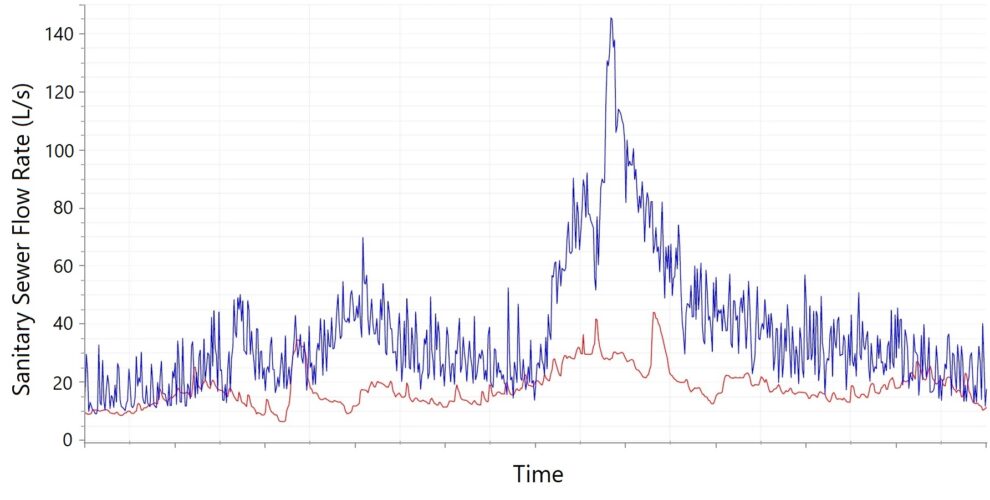
York Region’s I&I Reduction Standard
I&I must be both reduced within the system and prevented in newly constructed sewers. Data from the Region’s flow monitoring program and lessons learned from existing practices has determined updates and more detailed requirements were needed to design, construct, inspect and test mainline sewers, maintenance holes and lateral pipes to supplement existing municipal and Provincial standards.
In 2011, York Region published a Sanitary Sewer System Inspection, Testing and Acceptance Guideline which several local cities and towns adopted. Newly developed public and private partnership programs further encouraged implementation, providing capacity incentives. However, there was still a need for consistent I&I reduction requirements in both the public and private right of way. To fill this gap, York Region developed the Inflow and Infiltration Reduction Standard for Sewers Servicing New Development, which was endorsed by York Regional Council in February 2022.
To ensure the Standard is practical, implementable, cost-effective and easily adoptable by designers, inspectors, contractors and other industry stakeholders, the Region engaged with all stakeholders and committees at various stages and on a variety of topics.
The primary goals of the Standard are to:
- Adopt best management practices for design and construction, testing and inspection to address gaps identified in existing standards
- Drive consistent I&I reduction requirements across all nine local cities and towns, especially for watertightness
- Avoid unnecessary maintenance in the long term and reduce risk of basement flooding, while freeing up capacity to accommodate growth
- Increase system resiliency to extreme rainfall events occurring more frequently due to climate change
The Standard introduced new design, construction and inspection requirements on both public and private sanitary infrastructure to ensure watertightness and enhance public environmental health and safety by reducing the probability of basement flooding and raw sewage spills into the environment.
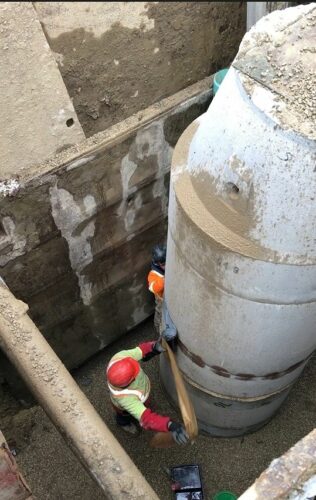
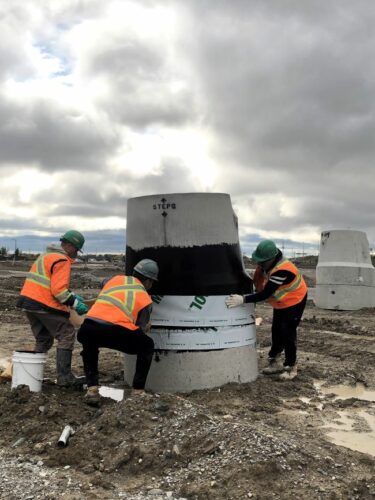
As one of only a few regional municipalities developing standards specifically targeting I&I, York Region’s new Standard adopts best management practices and drives consistent I&I reduction requirements across all nine local cities and towns. Furthermore, the Standard is applicable to both private and public property development. In Ontario, public infrastructure up to the property line is regulated by municipal standards, whereas private sewers from property line to building face are governed by Ontario Building Code. York Region’s Standard aligns with the Ontario government’s standards, bridging the gap between public and private side requirements.
The Standard features a guide to design and construction, including tables and decision charts for material selection, service connections and additional maintenance hole waterproofing requirements, specifically for areas of high groundwater table conditions. It also includes testing and inspection requirements, namely new air testing and closed-circuit television requirements with specifics on equipment, timing, frequency and procedures. These tests supplement Ontario Building Code requirements for service connections on the private right of way. Lastly, there are flow monitoring technologies and analysis methods, with a focus on new optional flow monitoring and thresholds for performance evaluation.
Meeting the challenges
Although the new Standard could increase costs by approximately 15 to 20 per cent, a cost-benefit analysis estimates that avoided impacts can save up to $258,000 per kilometre of pipe. These avoided costs include additional maintenance, pumping and treatment costs, spills to surface waters, environmental fines and residential sewer backups.
To meet the new requirements, sufficient skilled tradespeople may not be available at early phases of implementation. However, availability will increase as demand increases. Implementation of the Standard is predicted to create additional jobs for consultants and inspectors in York Region who will ensure conformance with testing and monitoring requirements.
On the horizon
York Region is implementing the Standard in collaboration with its nine local cities and towns who will require development applicants to meet the Standard as a condition of development approval secured through subdivision and site plan agreements and associated securities. By the end of the adoption period, all local municipalities will also have integrated the Standard into their local standards either by incorporating it into relevant sections or creating an amendment to existing design and construction standards.
Implementing the Standard will help York Region achieve its overall reduction target of 40 MLD. By 2031, an estimated 4.3 MLD of I&I, equivalent to the daily wastewater flow from about 4,500 homes, can be eliminated by adopting the new Standard. In selected areas, the Region will undertake pilot flow monitoring programs to demonstrate the effectiveness of the Standard during the implementation phase.
This approach for proactively preventing I&I can be integrated into any municipal standards, adding a higher level of stringency beyond other codes and standards. With the impacts of climate change increasing the intensity of storm events, preventing I&I in new developments is a cost-effective way to improve resiliency and free up capacity.
Ranin Nseir, M.Eng., P.Eng., is a Project Manager with System Sustainability Management leading York Region’s long-term Inflow and Infiltration (I&I) Reduction Strategy and Analysis.
Melinda Szarics is a chemical engineering student at the University of Toronto.
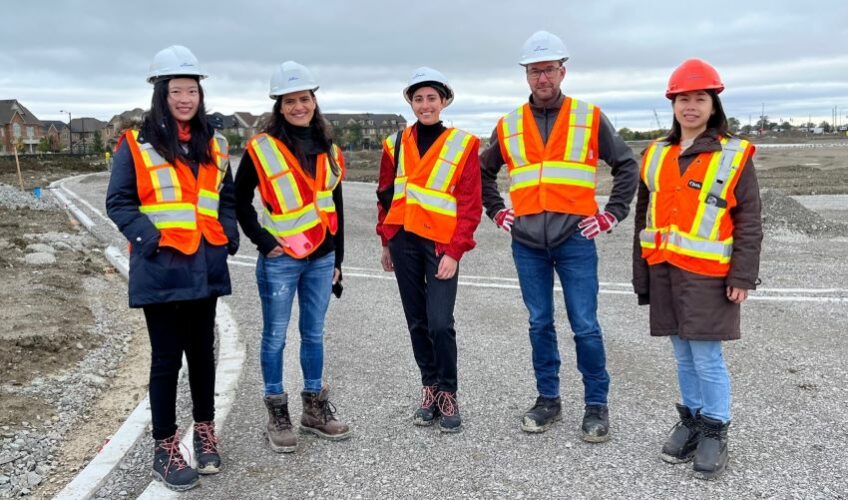
The Inflow and Infiltration Strategy and Analysis team at York Region consists of a group of infrastructure engineers, coordinators, and engineering students, reducing I&I with a data-driven and strategic approach.

